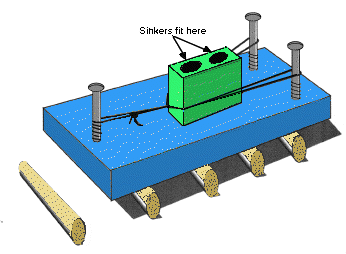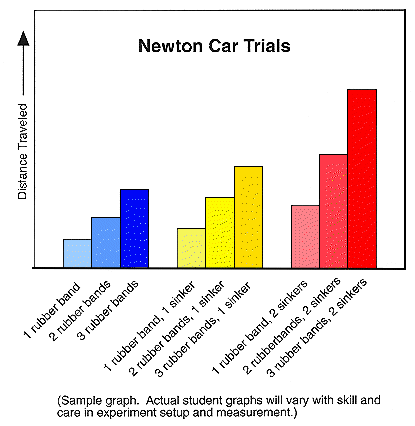| Newton
Car
Objective:
To demonstrate Newton's Second Law of Motion by showing the reaction
of a rolling car by increasing its mass and acceleration.
TOPIC:
Propulsion
Description: In
this activity, students test a slingshot-like device that throws a wooden
block that causes the car to move in the opposite direction.
EDITED BY:
Roger Storm, NASA Glenn Research Center

Materials
and Tools:
- 1 Wooden block
about 1Ox2Ox2.5 cm
- 1 Wooden block
about 7.5x5x2.5 cm
- 3 3-inch No. 10
wood screws (round head)
- 12 Round pencils
or short lengths of
similar dowel rods
- 3 Rubber bands
- Cotton string
- Matches
- 6 Lead fishing
sinkers (about 1/2 ounce each)
- Drill and bit
(bit size determined by the diameter of the fishing sinkers)
- Vice
- Screwdriver
- Meter stick
Procedure:
- Screw the three
screws in the large wood block as shown in the diagram.
- Hold the short
piece of wood with a vice and drill two holes large enough to drop two
sinkers in each.
- Tie the string
into several small loops of the same size.
- Place one string
loop over a rubber band and then place the ends of the rubber band over
the two screws on one end of the large wood block. Pull the rubber band
back like a slingshot and slip the string over the third screw to hold
the rubber band stretched.
- On a level table
top arrange the pencils or dowel rods in a row like railroad ties. Be
sure to mark the position of each dowel rod to make the experiment exactly
the same way each time it is tried. Place the large block on one end
of the row so that the tips of each single screw points toward the other
dowel rods. Slip the small block (without sinkers) into the rubber bands.
- Light a match
and ignite the ends of the string hanging down from the loop. When the
string burns through, the rubber band will throw the block off the car
and the car will roll in the other direction. Measure how far the car
travels along the table top.
- Reset the equipment
and add a second rubber band. Again, light the string, then measure
and record how far the car travels.
- Reset the equipment
and try again with 3 rubber bands. Then try again with one rubber band
and two sinkers, 4 sinkers, etc.
- Plot the data
from each of the experiments on a graph like the one below.
Discussion:
The Newton Car provides an excellent demonstration of Isaac Newton's Second
Law of Motion. By repeated trials of the experiment, it will become clear
that the distance the car travels depends on the number of rubber bands
used and the mass of the block being expelled. By adding sinkers to the
block, the mass of the block is increased. By adding rubber bands, the
acceleration of the block increases. (Refer to the chapter on rocket principles
for a more detailed explanation of this law. The cannon and cannon ball
example in the chapter is very similar to the Newton Car.)

Teaching Notes and
Questions:
This activity offers
a number of opportunities to combine science and mathematics. Mathematic
skills that can be employed include measurement, recording data, plotting
data on a graph, and interpreting graphical data.
Because this activity
involves the use of matches, be sure to exercise proper safety procedures.
Caution: Provide
adequate ventilation and a place to dispose of used matches. Scissors
can be substituted for the matches but are not as effective. Using scissors
requires some practice because the scissors must be quickly withdrawn
after cutting the string so as to not interfere with the reaction motion
of the car. Permit students to test this principle for themselves by first
stepping and then jumping off a stationary skateboard. Observe how far
the skateboard travels.
Caution: Be
sure to have a student spotter nearby so the student will not get hurt
jumping from the skateboard.
| 